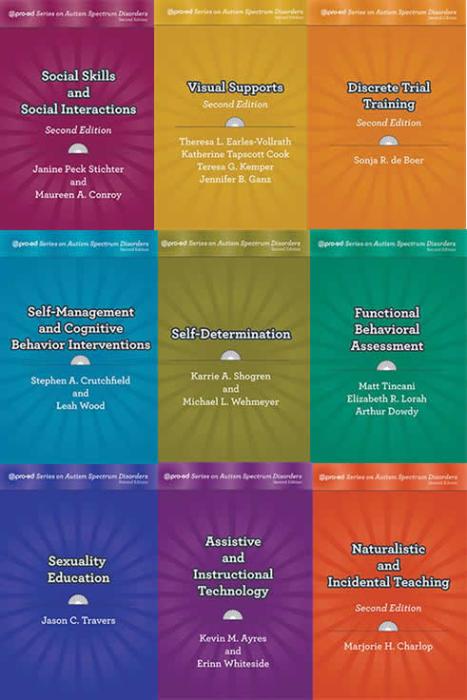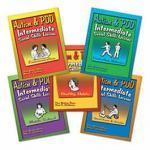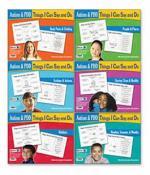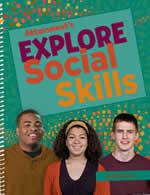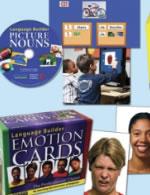PROED Series on Autism Spectrum Disorders
Additional Components:
Instructional Books for Teachers and Parents
This Series on Autism Spectrum Disorders Second Edition is designed for both professionals and parents. It provides critical information for selecting and using scientifically based methods for intervention with children and adolescents. Written in a quickly accessible, user-friendly style by qualified and experienced professionals, the books discuss and illustrate numerous practical solutions and strategies for working with learners with autism or other pervasive developmental...
This Series on Autism Spectrum Disorders Second Edition is designed for both professionals and parents. It provides critical information for selecting and using scientifically based methods for intervention with children and adolescents. Written in a quickly accessible, user-friendly style by qualified and experienced professionals, the books discuss and illustrate numerous practical solutions and strategies for working with learners with autism or other pervasive developmental disorders. The books in the series are similar in format and flexible enough to adapt to particular learning situations. Select the specific title needed or order the value saving series combination. 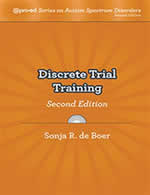 Discrete trial training (DTT) is a method of teaching individuals with autism spectrum disorder (ASD) based on applied behavior analysis (ABA). Skills are broken into discrete steps and then taught in massed trials. With DTT, steps are taught one at a time, instead of teaching an entire skill all at once. Concepts covered include errorless learning, methods of reinforcement, and how to use behavior momentum. The text explains how to collect, interpret, and use data to make teaching decisions. Finally, the text details a method for evaluating implementation of DTT.
Discrete trial training (DTT) is a method of teaching individuals with autism spectrum disorder (ASD) based on applied behavior analysis (ABA). Skills are broken into discrete steps and then taught in massed trials. With DTT, steps are taught one at a time, instead of teaching an entire skill all at once. Concepts covered include errorless learning, methods of reinforcement, and how to use behavior momentum. The text explains how to collect, interpret, and use data to make teaching decisions. Finally, the text details a method for evaluating implementation of DTT.
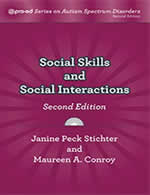 Social Skills and Social Interactions is written to enhance the quality and quantity of social interactions of individuals with autism spectrum disorder (ASD) and their peers. The text describes social competence and peer-related social behaviors, a multi-source functional approach to assessment, and evidence-based practices for fostering peer-related social interactions. This book provides a systematic process for educators to assess, plan for, and support students' social behaviors with peers in the classroom. 64 pages " 6" x 9" " softcover " ©2018
Social Skills and Social Interactions is written to enhance the quality and quantity of social interactions of individuals with autism spectrum disorder (ASD) and their peers. The text describes social competence and peer-related social behaviors, a multi-source functional approach to assessment, and evidence-based practices for fostering peer-related social interactions. This book provides a systematic process for educators to assess, plan for, and support students' social behaviors with peers in the classroom. 64 pages " 6" x 9" " softcover " ©2018
Contents
- Introduction
- What Is PeerRelated Social Competence?
- PeerRelated Social Skills Assessment
- Determining the Type and Delivery Method of Instruction
- Matching Instruction to Context
- Conclusion
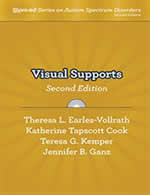 Visual supports are essential components of programs serving students with autism spectrum disorders (ASD) and can help provide a variety of information that enables these students to better understand and complete tasks with greater independence. Visual Supports, Second Edition provides information to help educators and families utilize visual displays or cues, such as schedules, boundaries, labels, and consequence maps, to help students with ASD achieve improved learning outcomes. 136 pages " 6" x 9" " softcover " ©2018
Visual supports are essential components of programs serving students with autism spectrum disorders (ASD) and can help provide a variety of information that enables these students to better understand and complete tasks with greater independence. Visual Supports, Second Edition provides information to help educators and families utilize visual displays or cues, such as schedules, boundaries, labels, and consequence maps, to help students with ASD achieve improved learning outcomes. 136 pages " 6" x 9" " softcover " ©2018
Contents
- Creating Visual Supports for Students With Autism Spectrum Disorders
- Visual Supports That Provide Information
- Visual Strategies That Support Behavior and Emotional Regulation
- Visual Supports That Structure the Learning Environment
- Visual Supports That Enhance Cognition and Language Development
- Visual Supports That Enhance Comprehension of Classroom Instruction
- Visual Strategies That Support Conversation and Social Skills
 Discrete trial training (DTT) is a method of teaching individuals with autism spectrum disorder (ASD) based on applied behavior analysis (ABA). Skills are broken into discrete steps and then taught in massed trials. With DTT, steps are taught one at a time, instead of teaching an entire skill all at once. Concepts covered include errorless learning, methods of reinforcement, and how to use behavior momentum. The text explains how to collect, interpret, and use data to make teaching decisions. Finally, the text details a method for evaluating implementation of DTT.
Discrete trial training (DTT) is a method of teaching individuals with autism spectrum disorder (ASD) based on applied behavior analysis (ABA). Skills are broken into discrete steps and then taught in massed trials. With DTT, steps are taught one at a time, instead of teaching an entire skill all at once. Concepts covered include errorless learning, methods of reinforcement, and how to use behavior momentum. The text explains how to collect, interpret, and use data to make teaching decisions. Finally, the text details a method for evaluating implementation of DTT. Examples and practice exercises are also provided throughout the book to help readers gain guided practice and a firm understanding of the concepts and skills that form the foundation for DTT. 156 pages " 6" x 9" " softcover " ©2018
Contents
- Applied Behavior Analysis As It Relates to Autism Spectrum Disorder and Discrete Trial Training
- The Antecedent, Behavior, and Consequence Paradigm
- Using the Discrete Trial Method to Teach Skills
- Providing a Structured Teaching Environment for Skill Acquisition
- Assessing Students and Establishing an Overall DTT Program
- DataBased Decision Making
- Performance Evaluation of Instructor Implementation of DTT
- Conclusion
 Naturalistic and Incidental Teaching Second Edition provides a primer on naturalistic teaching strategies and incidental teaching in the classrooms of students with autism spectrum disorder (ASD). This book includes information on what these strategies are and how to use them, and related information and literature.
Naturalistic and Incidental Teaching Second Edition provides a primer on naturalistic teaching strategies and incidental teaching in the classrooms of students with autism spectrum disorder (ASD). This book includes information on what these strategies are and how to use them, and related information and literature.
Naturalistic teaching strategies (NaTS) are evidence based interventions, rooted in applied behavior analysis, that are carried out in loosely structured environments, akin to what occurs in the natural environment at home. Incidental teaching (IT) is a naturalistic teaching method that encourages the involvement of parents, peers, and siblings in instructional activities and treatment. Incidental teaching is designed to facilitate and extend skill generalization and maintenance, and makes systematic use of natural reinforcement. 72 pages " 6" x 9" " softcover " ©2018
Contents
- Naturalistic Teaching Strategies
- Three Basic Tenets of NaTS
- Why Use Naturalistic Teaching Strategies?
- What is Incidental Teaching?
- Incidental Teaching Steps
- Treatment Procedures for Implementing Incidental Teaching
- Comments on Incidental Teaching and Parent Training
- Conclusion
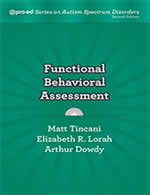 Functional Behavior Assessment describes a process to develop successful, function based intervention plans and design maximally effective management programs for children and youth with autism spectrum disorder (ASD). Functional behavior assessment (FBA) is an information gathering process to identify environmental variables that produce challenging behaviors. This book presents the foundations of FBA, the steps in the FBA process, data collection procedures to complete an FBA, and guidelines for developing function based interventions. 80 pages " 6" x 9" " softcover " ©2018
Functional Behavior Assessment describes a process to develop successful, function based intervention plans and design maximally effective management programs for children and youth with autism spectrum disorder (ASD). Functional behavior assessment (FBA) is an information gathering process to identify environmental variables that produce challenging behaviors. This book presents the foundations of FBA, the steps in the FBA process, data collection procedures to complete an FBA, and guidelines for developing function based interventions. 80 pages " 6" x 9" " softcover " ©2018
Contents
- Introduction
- Assumptions of FBA
- The FBA Process: An Overview
- Collecting FBA Data
- FunctionBased Interventions
- Conclusion
 Self-Determination offers specific and clearly described strategies for ensuring that individuals with autism spectrum disorder (ASD) are fully involved in their program plans and outcomes. Research suggests that self-determination, defined as acting as the causal agent in ones' own life, results in more positive outcomes in school, postschool employment, postsecondary education, and community living. However, students with ASD report lower levels of self-determination than their same age peers. This book is designed for teachers, other direct support personnel, and families, with the aim of enabling them to support children and youth with ASD in acquiring the skills they need to become more self-determined. 84 pages " 6" x 9" " softcover " ©2018
Self-Determination offers specific and clearly described strategies for ensuring that individuals with autism spectrum disorder (ASD) are fully involved in their program plans and outcomes. Research suggests that self-determination, defined as acting as the causal agent in ones' own life, results in more positive outcomes in school, postschool employment, postsecondary education, and community living. However, students with ASD report lower levels of self-determination than their same age peers. This book is designed for teachers, other direct support personnel, and families, with the aim of enabling them to support children and youth with ASD in acquiring the skills they need to become more self-determined. 84 pages " 6" x 9" " softcover " ©2018
Contents
- Introduction
- Choice Making Skills
- Problem Solving and Decision Making Skills
- Self-Advocacy Skills
- Goal Setting and Attainment Skills
- Self Regulation and Self-Management Skills
- Self Awareness and Self-Knowledge
- The Self Determined Learning Model of Instruction
- Conclusion
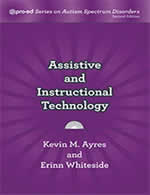 Assistive and Instructional Technology is a guide to using technology in the classrooms of students with autism spectrum disorder (ASD). This book describes the difference between assistive and instructional technology and how they are related. It identifies key features to look for in new technology and provides step-by-step support for using it effectively. This succinct resource describes critical aspects of current technology that result in improved learning outcomes. 88 pages " 6" x 9" " softcover " ©2018
Assistive and Instructional Technology is a guide to using technology in the classrooms of students with autism spectrum disorder (ASD). This book describes the difference between assistive and instructional technology and how they are related. It identifies key features to look for in new technology and provides step-by-step support for using it effectively. This succinct resource describes critical aspects of current technology that result in improved learning outcomes. 88 pages " 6" x 9" " softcover " ©2018
Contents
- Introduction
- Types of Technology in the Learning Environment
- Selecting Technology for the Learning Environment
- Planning Implementation and Monitoring Effects
- Designing Technology Solutions for Discrete Trial Instruction
- Designing Instruction for MultiStep Skills
- Summary and Conclusions
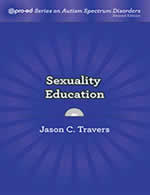 Sexuality Education provides a framework for comprehensive sexuality education (CSE) for the healthy and safe sexual development of learners with autism spectrum disorder (ASD). Comprehensive sexuality education includes traditional sex education topics, such as reproduction and sexually transmitted diseases, and incorporates learning about various relationships, decision making skills and communication, specific sexual behaviors, and aspects of diversity as related to sexuality, among other topics.
Sexuality Education provides a framework for comprehensive sexuality education (CSE) for the healthy and safe sexual development of learners with autism spectrum disorder (ASD). Comprehensive sexuality education includes traditional sex education topics, such as reproduction and sexually transmitted diseases, and incorporates learning about various relationships, decision making skills and communication, specific sexual behaviors, and aspects of diversity as related to sexuality, among other topics.
This book promotes a behavior analytic approach to teaching CSE to learners with ASD. This approach involves identifying behaviors to be increased and decreased and defining those behaviors in measurable terms. The goals of comprehensive sexuality education for individuals with ASD also include preventing sexual abuse, fostering healthy relationships, preventing and addressing inappropriate behavior, promoting health and hygiene, and improving self-determination.
Sexuality Education provides information about using visual supports as a specialized instructional strategy. On pages 2932, the text refers to the concept of using a model of concentric circles for teaching about appropriate behavior within various relationships. A commercial product that uses this strategy is Circles® Intimacy & Relationships, a video series program published by James Stanfield and Company, Inc. 96 pages " 6" x 9" " softcover " ©2018
Contents
- Introduction
- Rationale for Comprehensive Sexuality Education
- Comprehensive Sexuality Education Content, Team Roles, and Professional Responsibilities
- Interventions and Supports for Sexuality Education
- Specific Issues
- Conclusion
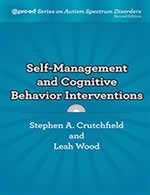 Self-Management and Cognitive Behavior Interventions is a guide to using cognitive behavior modification (CBM) with students with autism spectrum disorder (ASD) to increase the student's self-management.
Self-Management and Cognitive Behavior Interventions is a guide to using cognitive behavior modification (CBM) with students with autism spectrum disorder (ASD) to increase the student's self-management.
CBM approaches include self-management intervention (SMI) and cognitive behavior intervention (CBI). SMI is synonymous with self-regulation and encompasses a variety of cognitive processes, such as controlling emotions, attending to relevant information, planning future behavior, remaining flexible through unplanned setbacks, and behaving in a way that enhances the likelihood of achieving future goals. SMI is managed by the student and is used to address a wide variety of target behaviors. CBI helps individuals examine their thoughts and emotions and adopt actions that change their thinking as well as their behavior.
This book examines specific, research-based cognitive behavior interventions and self-management interventions and explores designing and implementing interventions for students with ASD. 108 pages " 6" x 9" " softcover " ©2018
Contents
Part One: Self-Management Interventions
- What Are Self-Management Interventions?
- What Type of Students With ASD Benefit From SMIs?
- What Are Goal Setting Interventions?
- What Types of Goals Should We Support Students With ASD in Setting?
- What Prerequisite Skills Do Students With ASD Need for Goal Setting Interventions?
- Steps in Implementing Goal Setting Interventions
- Why Are Goal Setting Interventions Important to Students With ASD?
- What Are Self-Monitoring Interventions?
- What Prerequisite Skills Do Students With ASD Need for Self-Monitoring Interventions?
- Steps in Implementing Self-Monitoring Interventions
- What Are Self-Reinforcement Interventions?
- What Prerequisite Skills Do Students With ASD Need for Self-Reinforcement Interventions?
- Steps in Implementing Self-Reinforcement Interventions
- Why Are Self-Reinforcement Interventions Important to Students With ASD?
- Self-Management Case Study
Part Two: Cognitive Behavior Interventions
- What Are Cognitive Behavior Interventions?
- Multicomponent CBI Programs
- CBI Case Study: Mr. Hill's Seventh Grade Homeroom
Item #
Products
Price
Wishlist
Qty
Requested quantity is not available at this time
PX7632WB
Social Skills and Social Interactions
$23.00
Requested quantity is not available at this time
PX7633WB
Visual Supports
$23.00
Requested quantity is not available at this time
PX7634WB
Discrete Trial Training
$23.00
Requested quantity is not available at this time
PX7635WB
Naturalistic and Incidental Teaching
$23.00
Requested quantity is not available at this time
PX7636WB
Functional Behavior Assessment
$23.00
Requested quantity is not available at this time
PX7637WB
Self-Determination
$23.00
Requested quantity is not available at this time
PX7638WB
Assisstive and Instructional Technology
$23.00
Requested quantity is not available at this time
PX7639WB
Sexuality Education
$23.00
Requested quantity is not available at this time
PX7640WB
Self-Management and Cognative Behavior Interventions
$23.00
Requested quantity is not available at this time
PX7631WB
Autism Spectrum Disorders Complete Series (9 Books)
$160.00
Only the first 5 items are displayed. Click here to
See all items
